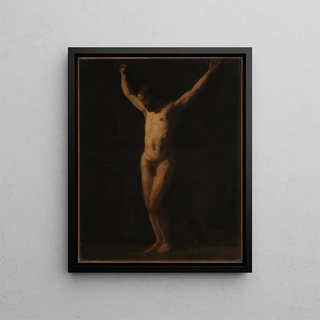Art print | Crucifixion - William Merritt Chase


View from behind

Frame (optional)
Reproduction Art print Crucifixion - William Merritt Chase – Engaging introduction
The "Crucifixion" by William Merritt Chase is a work that transcends the simple frame of painting to become a true spiritual experience. By immersing oneself in this representation, the viewer is immediately confronted with an emotional intensity that evokes deep reflections on suffering and redemption. Chase, known for his mastery of colors and light, succeeds here in capturing the very essence of human drama, while integrating a sacred dimension that resonates. This work, both timeless and deeply rooted in its era, invites contemplation that goes far beyond mere observation.
Style and uniqueness of the work
Chase's style in the "Crucifixion" is characterized by a bold and innovative approach. The artist uses a palette of rich and vibrant colors, creating striking contrasts that emphasize the central figures of the scene. The play of light and shadow, carefully orchestrated, confers an almost three-dimensional depth to the composition. The meticulous details of the drapery and facial expressions of the characters testify to exceptional craftsmanship, while revealing a sensitivity to human psychology. Chase does not merely reproduce a religious scene; he reinvents it, making it accessible and relevant for the modern viewer. This ability to fuse tradition and innovation is what makes his work so singular and memorable.
The artist and his influence
William Merritt Chase, an emblematic figure of the American Impressionist movement, managed to mark his era with his innovative approach to painting. Born in 1849, he was influenced by the great European masters, while developing a distinctive style of his own. Chase was a pioneer in the use of light and color, seeking to capture fleeting moments and intense emotions. His impact on his contemporaries and subsequent generations is undeniable. By incorporating elements of nature and everyday life into his works, he paved the way for a new way of approaching art. The "Crucifixion" fits into this lineage, bearing witness to his constant desire to explore universal themes while remaining faithful to his artistic identity.
A decoration

Matte finish

View from behind

Frame (optional)
Reproduction Art print Crucifixion - William Merritt Chase – Engaging introduction
The "Crucifixion" by William Merritt Chase is a work that transcends the simple frame of painting to become a true spiritual experience. By immersing oneself in this representation, the viewer is immediately confronted with an emotional intensity that evokes deep reflections on suffering and redemption. Chase, known for his mastery of colors and light, succeeds here in capturing the very essence of human drama, while integrating a sacred dimension that resonates. This work, both timeless and deeply rooted in its era, invites contemplation that goes far beyond mere observation.
Style and uniqueness of the work
Chase's style in the "Crucifixion" is characterized by a bold and innovative approach. The artist uses a palette of rich and vibrant colors, creating striking contrasts that emphasize the central figures of the scene. The play of light and shadow, carefully orchestrated, confers an almost three-dimensional depth to the composition. The meticulous details of the drapery and facial expressions of the characters testify to exceptional craftsmanship, while revealing a sensitivity to human psychology. Chase does not merely reproduce a religious scene; he reinvents it, making it accessible and relevant for the modern viewer. This ability to fuse tradition and innovation is what makes his work so singular and memorable.
The artist and his influence
William Merritt Chase, an emblematic figure of the American Impressionist movement, managed to mark his era with his innovative approach to painting. Born in 1849, he was influenced by the great European masters, while developing a distinctive style of his own. Chase was a pioneer in the use of light and color, seeking to capture fleeting moments and intense emotions. His impact on his contemporaries and subsequent generations is undeniable. By incorporating elements of nature and everyday life into his works, he paved the way for a new way of approaching art. The "Crucifixion" fits into this lineage, bearing witness to his constant desire to explore universal themes while remaining faithful to his artistic identity.
A decoration






